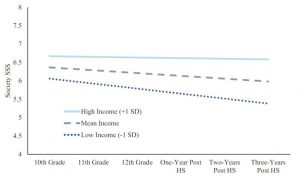Social status refers to one’s rank or standing relative to others. Often conceptualized with respect to objective indicators of socioeconomic status (i.e., income, education), people of higher status tend to have better health. One’s own appraisal of social standing, known as subjective social status (SSS), is also consistently related to health and well-being, even after accounting for objective indicators of socioeconomic status.
As they age, adolescents develop a sense of their social standing with respect to society in general (society SSS) and with respect to their peers in school (school SSS). Recent work from our lab has suggested that adolescents’ perceptions of social status become more related to social factors over time and that SSS may relate to health by influencing adolescents’ responses to stress.
Development of Subjective Social Status

In a paper recently published in Developmental Psychology, we report how society and school SSS change over time across the transition from high school. Adolescents’ society SSS generally declined over time, especially for adolescents with lower family income, females, adolescents who did not enroll in college, and adolescents whose parents reported lower SSS. Adolescents reported lower school SSS after entering college, although school SSS was generally stable across years during high school and during college. Declines in school SSS were also observed for Latinos and females. Lower SSS was linked with higher odds of obesity and greater depressive symptoms even after accounting for family income and education.
Declines in SSS are especially common among youth from disadvantaged groups and lower SSS indicates risk for poorer health.
We examined how students develop a sense of their SSS at their university and whether associations between SSS and health change across the first year of college in a paper in the journal Psychology and Health. Students generally perceived higher SSS each month across the first-year of college. Students with lower SSS at their university reported more depressive and anxious symptoms. These associations, however, were strongest at the start of the academic year as students transitioned to college and weakened as students adjusted to college. Overall, youth who experienced early life stress tended to have lower SSS in terms of society, but not at school.
Subject Social Status and Stress Responses
We reported in a paper published in Stress that lower society SSS was related to greater psychological and physiological responses to stress. Participants participated in a social-evaluative stress test in which they presented a speech and completed a difficult math task while being observed by judges. Adolescents with lower SSS showed greater increases in fear following the task and faster hypothalamic-pituitary-adrenal (HPA) axis responses to the task. Lower SSS earlier in high school was associated with parasympathetic nervous system responses that are linked with poorer mental health.
Declines in SSS are especially common among youth from disadvantaged groups and lower SSS indicates risk for poorer health.
Conclusion
Our work suggests that youth diverge in their sense of their social standing during adolescence, and the mere perception of having low status can influence stress responses and worsen health in adolescents and college students. Further work is needed to identify how SSS relates to daily health and well-being and what factors can buffer the negative impacts of perceiving low social status.

